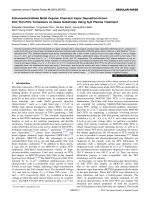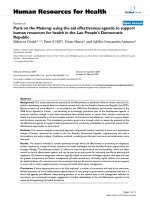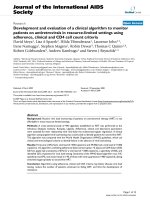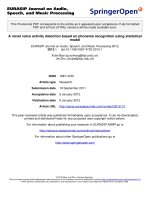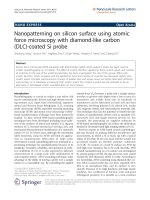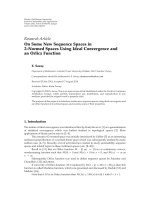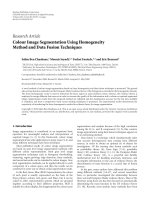Polyp segmentation on colonoscopy image using improved Unet and transfer learning
Bạn đang xem bản rút gọn của tài liệu. Xem và tải ngay bản đầy đủ của tài liệu tại đây (977.63 KB, 15 trang )
Research
Polyp segmentation on colonoscopy image
using improved Unet and transfer learning
Le Thi Thu Hong1*, Nguyen Sinh Huy1, Nguyen Duc Hanh1, Trinh Tien Luong1,
Ngo Duy Do1, Le Huu Nhuong2, Le Anh Dung2
1
Military Information Technology Institute, Academy of Military Science and Technology;
Military Medical Hospital 354/General Department of Logistics.
*
Corresponding author:
Received 14 Sep 2022; Revised 7 Dec 2022; Accepted 15 Dec 2022; Published 30 Dec 2022.
DOI: />2
ABSTRACT
Colorectal cancer is among the most common malignancies and can develop from high-risk
colon polyps. Colonoscopy remains the gold-standard investigation for colorectal cancer
screening. The procedure could benefit greatly from using AI models for automatic polyp
segmentation, which provide valuable insights for improving colon polyp dection.
Additionally, it will support gastroenterologists during image analysation to correctly choose
the treatment with less time. In this paper, the framework of polyp image segmentation is
developed by a deep learning approach, especially a convolutional neural network. The
proposed framework is based on improved Unet architecture to obtain the segmented polyp
image. We also propose to use the transfer learning method to transfer the knowledge learned
from the ImageNet general image dataset to the endoscopic image field. This framework used
the Kvasir-SEG database, which contains 1000 GI polyp images and corresponding
segmentation masks according to annotation by medical experts. The results confirmed that
our proposed method outperforms the state-of-the-art polyp segmentation methods with
94.79% dice, 90.08% IOU, 98.68% recall, and 92.07% precision.
Keywords: Artificial Intelligence; Colonoscopy; Polyp Segmentation; Transfer Learning; Unet.
1. INTRODUCTION
Colorectal cancer (CRC) is one of the most common causes of cancer-related death in
the world for both men and women, with 576,858 deaths (accounting for 5.8% of all
cancer deaths) worldwide in 2020 [1]. Colorectal polyps are irregular cell growth from
the mucous membrane in the gastrointestinal (GI) tract that are forerunners of colorectal
cancer. According to anatomical findings, the structure of polyps is distinguished from
normal mucosa by color, size, and surface type. The surface of polyps can be flat,
elevated, or pedunculated based on a change in the gastrointestinal tract [2].
Colonoscopy is the primary method for colorectal cancer screening. However,
colonoscopy suffers from human errors and failure to fully recognize polyps [3].
Automatic polyp detection is highly desirable for colon screening due to the polyp miss
rate by physicians during colonoscopy.
The computerized algorithms for polyp detection are divided into the classification of
polyps against non-polyp and pixel-polyp segmentation. Segmentation of polyps on
colonoscopy images is an image semantic segmentation task in which image pixels are
binary classified, either into polyp class pixels or non-polyp class pixels. Figure 1 is an
illustration of the polyp segmentation. The segmentation of colonoscopy images is an
effective modality to obtain regions of interest (ROIs) that contain a polyp. The ROI
detection in each image is based on pixel distributions for improving the polyp diagnosis
Journal of Military Science and Technology, Special issue No.6, 12- 2022
41
Computer science and Control engineering
with less time. Over the past years, researchers have made several efforts to develop
Computer-Aided Diagnosis(CADx) prototypes for automated polyp segmentation. Most
of the prior polyp segmentation approaches were based on analyzing polyp color,
texture, shape, or edge information to segment polyp regions. More recently, deep neural
networks have been widely used to solve medical image segmentation problems,
including polyp segmentation. The CADx system for automatically segmenting out
polyps from normal mucosa on colonoscopy images can be an effective clinical tool that
helps endoscopists for faster screening and higher accuracy.
Figure 1. Polyp segmentation: (a) Input image, (b) Results of polyp segmentation,
(c): Visual display of polyp segmentation.
Among various deep learning models, UNet [4] and its variants have demonstrated
impressive performance in biomedical image segmentation. Motivated by the success of
UNet, in this work, we propose a novel polyp segmentation method based on the UNet
architecture. We aim to evaluate different CNN architectures (e.g. MobileNet [5],
Resnet[6], and EfficentNets [7]) as the encoder of the U-net for polyp segmentation. We
choose EfficentNet as the backbone of U-net for our segmentation polyp model because
its performance is the highest. We also use the transfer learning method to transfer the
knowledge learned from the ImageNet general image dataset to the endoscopic image
field. We perform experiments using recent public datasets for polyp segmentation:
Kvasir-SEG [8] for training our model and CVC-ColonDB [9], EITS-Larib [10] for
testing. Finally, we evaluate our proposed method and compare it with state-of-the-art
(SOTA) approaches.
The rest of the article is organized as section 2 reviews related research. In section 3,
we describe our proposed method of polyp segmentation using Unet in detail. Section 4
outlines our experiment settings, experimental results, and discussion. Finally, in section
5, we summarize and conclude this work.
2. RELATED WORKS
The deep learning-based approach for polyp segmentation has gained much attention
in recent years due to the automatic feature extraction process to segment polyp regions
42
L. T. T. Hong, …, L. A. Dung, “Polyp segmentation on colonoscopy … and transfer learning.”
Research
with unprecedented precision. Qadir et al. [11] proposed using Mask-RCNN
incorporated with traditional CNN-based feature extractors to provide bounding boxes of
the polyp regions. Kang and Gwak [12] used Mask-RCNN, which relies on ResNet50
and ResNet101, as a backbone structure for automatic polyp detection and segmentation.
Akbari et al. [13] applied FCN network to polyp segmentation and combined Otsu
thresholding to select the largest connected region. Sun et al. [14] utilized Unet
architecture for polyp segmentation and further introduced a dilated convolution to learn
high-level semantic features without resolution reduction. Zhou et al. [15] proposed
UNet++ to redesign skip pathways and achieve better performance in polyp
segmentation. Jha et al. [16] also propose ResUNet++, which takes advantage of residual
blocks, squeeze and excitation units, ASPP, and the attention mechanism. Wang et al.
[17] used the SegNet architecture to detect polyps in real-time and with high sensitivity
and specificity. Afify et al. [18] presented an improved framework for polyp
segmentation based on image preprocessing and two types of SegNet architecture.
Despite the significant progress made by these methods, the performance of polyp
segmentation is still limited by the small size of polyp databases, which require
expensive and time-consuming manual labelling.
3. PROPOSED METHOD
3.1. Overview of the proposed method
The overall proposed method, which adapts U-net to segment polyp automatically, is
depicted in figure 2.
Figure 2. Flowchart of the proposed polyp segmentation framework.
We use the U-net architecture for polyps segmentation and evaluate the performance of
U-nets with different CNN encoders. We selected U-net architectures with EfficentNet B7
for our polyp segmentation framework because of the highest performance. We adopt a
transfer learning approach with UNet architecture for polyp segmentation by using UNet
with a CNN model pre-trained on the ImageNet dataset as the encoder.
To train the polyp segmentation network, we use a public polyp segmentation dataset
consisting of colonoscopy images and their corresponding pixel-level annotated polyp
masks that were annotated by colonoscopists. The asymmetric similarity loss function
[19] is used for training networks to address the unbalanced data problem. The
asymmetric similarity loss function is ����������������������������������������������������������������������������������������������������������������������������������������������������������������������������������������������������������������������������������������������������������������������������������������������������������������������������������������������������������������������������������������������������������������������������������������������������������������������������������������������������������������������������������������������������������������������������������������������������������������������������������������������������������������������������������������������������������������������������������������������������������������������������������������������������������������������������������������������������������������������������������������������������������������������������������������������������������������������������������������������������������������������������������������������������������������������������������������������������������������������������������������������������������������������������������������������������������������������������������������������������������������������������������������������������������������������������������������������������������������������������������������������������������������������������������������������������������������������������������������������������������������������������������������������������������������������������������������������������������������������������������������������������������������������������������������������������������������������������������������������������������������������������������������������������������������������������������������������������������������������������������������������������������������������������������������������������������������������������������������������������������������������������������������������������������������������������������������������������������������������������������������������������������������������������������������������������������������������������������������������������������������������������������������������������������������������������������������������������������������������������������������������������������������������������������������������������������������������������������������������������������������������������������������������������������������������������������������������������������������������������������������������������������������������������������������������������������������������������������������������������������������������������������������������������������������������������������������������������������������������������������������������������������������������������������������������������������������������������������������������������������������������������������������������������������������������������������������������������������������������������������������������������������������������������������������������������������������������������������������������������������������������������������������������������������������������������������������������������������������������������������������������������������������������������������������������������������������������������������������������������������������������������������������������������������������������������������������������������������������������������������������������������������������������������������������������������������������������������������������������������������������������������������������������������������������������������������������������������������������������������������������������������������������������������������������������������������������������������������������������������������������������������������������������������������������������������������������������������������������������������������������������������������������������������������������������������������������������������������������������������������������������������������������������������������������������������������������������������������������������������������������������������������������������������������������������������������������������������������������������������������������������������������������������������������������������������������������������������������������������������������������������������������������������������������������������������������������������������������������������������������������������������������������������������������������������������������������������������������������������������������������������������������������������������������������������������������������������������������������������������������������������������������������������������������������������������������������������������������������������������������������������������������������������������������������������������������������������������������������������������������������������������������������������������������������������������������������������������������������������������������������������������������������������������������������������������������������������������������������������������������������������������������������������������������������������������������������������������������������������������������������������������������������������������������������������������������������������������������������������������������������������������������������������������������������������������������������������������������������������������������������������������������������������������������������������������������������������������������������������������������������������������������������������������������������������������������������������������������������������������������������������������������������������������������������������������������������������������������������������������������������������������������������������������������������������������������������������������������������������������������������������������������������������������������������������������������������������������������������������������������������������������������������������������������������������������������������������������������������������������������������������������������������������������������������������������������������������������������������������������������������������������������������������������������������������������������������������������������������������������������������������������������������������������������������������������������������������������������������������������������������������������������������������������������������������������������������������������������������������������������������������������������������������������������������������������������������������������������������������������������������������������������������������������������������������������������������������������������������������������������������������������������������������������������������������������������������������������������������������������������������������������������������������������������������������������������������������������������������������������������������������������������������������������������������������������������������������������������������������������������������������������������������������������������������������������������������������������������������������������������������������������������������������������������������������������������������������������������������������������������������������������������������������������������������������������������������������������������������������������������������������������������������������������������������������������������������������������������������������������������������������������������������������������������������������������������������������������������������������������������������������������������������������������������������������������������������������������������������������������������������������������������������������������������������������������������������������������������������������������������������������������������������������������������������������������������������������������������������������������������������������������������������������������������������������������������������������������������������������������������������������������������������������������������������������������������������������������������������������������������������������������������������������������������������������������������������������������������������������������������������������������������������������������������������������������������������������������������������������������������������������������������������������������������������������������������������������������������������������������������������������������������������������������������������������������������������������������������������������������������������������������������������������������������������������������������������������������������������������������������������������������������������������������������������������������������������������������������������������������������������������������������������������������������������������������������������������������������������������������������������������������������������������������������������������������������������������������������������������������������������������������������������������������������������������������������������������������������������������������������������������������������������������������������������������������������������������������������������������������������������������������������������������������������������������������������������������������������������������������������������������������������������������������������������������������������������������������������������������������������������������������������������������������������������������������������������������������������������������������������������������������������������������������������������������������������������������������������������������������������������������������������������������������������������������������������������������������������������������������������������������������������������������������������������������������������������������������������������������������������������������������������������������������������������������������������������������������������������������������������������������������������������������������������������������������������������������������������������������������������������������������������������������������������������������������������������������������������������������������������������������������������������������������������������������������������������������������������������������������������������������������������������������������������������������������������������������������������������������������������������������������������������������������������������������������������������������������������������������������������������������������������������������������������������������������������������������������������������������������������������������������������������������������������������������������������������������������������������������������������������������������������������������������������������������������������������������������������������������������������������������������������������������������������������������������������������������������������������������������������������������������������������������������������������������������������������������������������������������������������������������������������������������������������������������������������������������������������������������������������������������������������������������������������������������������������������������������������������������������������������������������������������������������������������������������������������������������������������������������������������������������������������������������������������������������������������������������������������������������������������������������������������������������������������������������������������������������������������������������������������������������������������������������������������������������������������������������������������������������������������������������������������������������������������������������������������������������������������������������������������������������������������������������������������������������������������������������������������������������������������������������������������������������������������������������������������������������������������������������������������������������������������������������������������������������������������������������������������������������������������������������������������������������������������������������������������������������������������������������������������������������������������������������������������������������������������������������������������������������������������������������������������������������������������������������������������������������������������������������������������������������������������������������������������������������������������������������������������������������������������������������������������������������������������������������������������������������������������������������������������������������������������������������������������������������������������������������������������������������������������������������������������������������������������������������������������������������������������������������������������������������������������������������������������������������������������������������������������������������������������������������������������������������������������������������������������������������������������������������������������������������������������������������������������������������������������������������������������������������������������������������������������������������������������������������������������������������������������������������������������������������������������������������������������������������������������������������������������������������������������������������������������������������������������������������������������������������������������������������������������������������������������������������������������������������������������������������������������������������������������������������������������������������������������������������������������������������������������������������������������������������������������������������������������������������������������������������������������������������������������������������������������������������������������������������������������������������������������������������������������������������������������������������������������������������������������������������������������������������������������������������������������������������������������������������������������������������������������������������������������������������������������������������������������������������������������������������������������������������������������������������������������������������������������������������������������������������������������������������������������������������������������������������������������������������������������������������������������������������������������������������������������������������������������������������������������������������������������������������������������������������������������������������������������������������������������������������������������������������������������������������������������������������������������������������������������������������������������������������������������������������������������������������������������������������������������������������������������������������������������������������������������������������������������������������������������������������������������������������������������������������������������������������������������erformance with
78.53% Dice, 66.95% IoU. On CVC-ColonDB test set, the proposed method gets the
best results with 85.59% Dice, IoU 76.19%, recall of 88,07%, and precision of 86.78%.
Table 6. Comparison results on cross-dataset using Kvasir-SEG as the training set.
ETIS-Larib
CVC-ColonDB
Method
Dice(%)
IoU(%)
Dice(%)
IoU(%)
UNet [4]
60.25
n/a
66.12
n/a
UNet++[15]
58.43
n/a
65.21
n/a
ResUNet++ [16]
40.17
64.15
51.35
67.42
ResUNet++ TTA [21]
40.14
64.68
55.93
70.3
DoubleU-Net [20]
64.4
n\a
n\a
n\a
PolypSegNet[23]
71.8
n\a
n\a
n\a
Unet_EfficientNetB7
78.53
66.95
85.56
76.19
Table 7 presents the results and comparison with several SOTAs for polyp
Journal of Military Science and Technology, Special issue No.6, 12- 2022
51
Computer science and Control engineering
segmentation with CVC-ClinicDB as the training set. On ETIS-Larib test set, the
proposed method gives the best segmentation performance with 79.37% Dice, 68.65%
IoU, recall of 79.44%, and precision of 80.07%. The proposed method obtains the best
results on CVC-ColonDB test set: 86.8% Dice, 77.43% IoU, recall of 86,4%, and
precision of 85.52%. These results indicate that our method outperforms other SOTAs
on both test sets. Especially with the CVC-ColonDB test set, our Dice score is 12.1%
higher than PolypSegNet's [23], which is the second-highest method.
Table 7. Comparison results on cross-dataset using CVC-ClinicDB as the training set.
ETIS-Larib
CVC-ColonDB
Method
Dice(%)
IoU(%)
Dice(%)
IoU(%)
UNet [4]
57.25
n/a
65.32
n/a
U-Net++[15]
55.12
n/a
61.85
n/a
ResUNet++[16]
40.12
63.98
54.89
69.42
ResUNet++ TTA[21]
40.27
65.22
56.86
70.8
ResNet101-Mask-RCNN [11]
70.42
61.34
n\a
n\a
Ensemble Mask-RCNNs [12]
n\a
66.07
n\a
69.46
DoubleU-Net [20]
76.49
62.55
71.21
n/a
PolypSegNet[23]
68.6
n/a
74.7
n/a
Unet_EfficientNetB7
79.37
68.85
86.8
77.43
5.4. Result on 354 Hospital Dataset
We evaluate the accuracy of polyp segmentation on colonoscopy images on the
354_Hospital dataset. This is an unlabeled endoscopic image dataset collected at 354
Hospital. The dataset includes 4 colonoscopy videos with 867 colonoscopy images. The
model will predict polyp segmentation on the endoscopic images of the test dataset.
Predicted results are evaluated qualitatively by doctors. The evaluation metrics are
defined in table 8.
Table 8. Evalutated metrics for polyp segmentation on 354 Hospital Dataset.
Ground Truth
Polyp
Prediction
None polyp
Polyp
TP
(Right polyp
segmentation)
FN
(None polyp
segmentation)
None polyp
FP
(Wrong polyp
segmentation)
TN
(None polyp
segmentation)
Sensitive (%) =100*TP/(TP+FN)
52
L. T. T. Hong, …, L. A. Dung, “Polyp segmentation on colonoscopy … and transfer learning.”
Research
Table 9 shows the results of the polyp segmentation assessment by doctors.
Sensitivity (reflecting the probability that a case with polyps is correctly predicted) is
quite high with averaging 86.8%, highest at 90.7%, and lowest at 85.7%.
Table 9. Result of testing on 354 Hospital Dataset.
Video 1
Video 2
Video 3
Video 4
Average
Frames
94
287
213
87
681
TP
16
162
76
49
303
9
32
5
46
78
96
94
29
297
2
88.9
27
85.7
12
86.3
5
90.7
46
86.8
TN
FP
FN
Sensitive (%)
6. CONCLUSIONS
In this paper, we propose an improved UNet framework for polyp segmentation. We
present a novel UNet-based architecture extended from UNet with the EfficientNet B7
encoder. Besides, we use the transfer learning method to train and validate the proposed
method on various datasets, i.e., Kvasir-SEG, CVC-ClinicDB, CVC-ColonDB, EITSLarib with different scenarios of using training and test data. Our experimental results
show that the proposed method outperformed the state-of-the-art polyp segmentation
methods. Our research is still flawed, but we hope to try to break through existing
research results in a variety of ways. To improve segmentation performance, we plan to
explore other semantic segmentation models. Besides, we also continue to ensemble
models to boost the performance of models.
Acknowledgments: This research is funded by Academy of Military Science and Technology
(AMST) under Logistics science research mission in 2022.
REFERENCES
[1]. H. Sung, J. Ferlay, R. L. Siegel, M. Laversanne, I. Soerjomataram, A. Jemal, and F. Bray,
“Global cancer statistics 2020: GLOBOCAN estimates of incidence and mortality
worldwide for 36 cancers in 185 countries,” CA, A Cancer J. Clinicians, vol. 71, no. 3, pp.
209-249, (2021).
[2]. J.-F. Rey and R. Lambert, “ESGE recommendations for quality control in gastrointestinal
endoscopy: Guidelines for image documentation in upper and lower GI endoscopy”,
Endoscopy, vol. 33, no. 10, pp. 901-903, (2001).
[3]. A. M. Leufkens, M. G. H. van Oijen, F. P. Vleggaar, and P. D. Siersema. "Factors
influencing the miss rate of polyps in a back-to-back colonoscopy study," Endoscopy,
44(05):470475, (2012).
[4]. O. Ronneberger, P. Fischer, and T. Brox, “U-Net: Convolutional networks for biomedical
image segmentation” in Proc. Int. Conf. Med. Image Comput. Comput.-Assist. Intervent.
Cham, Switzerland: Springer, pp. 234-241, (2015).
[5]. Sandler, Mark, et al. "Mobilenetv2: Inverted residuals and linear bottlenecks. In 2018
IEEE." CVF Conference on Computer Vision and Pattern Recognition, (2018).
[6]. He, Kaiming, et al. "Deep residual learning for image recognition." Proceedings of the
IEEE conference on computer vision and pattern recognition. (2016).
Journal of Military Science and Technology, Special issue No.6, 12- 2022
53
Computer science and Control engineering
[7]. Tan, Mingxing, and Quoc V. Le. "EfficientNet: Rethinking Model Scaling for
Convolutional Neural Networks." arXiv preprint arXiv:1905.11946 (2019).
[8]. D. Jha, P. H. Smedsrud, M. A. Riegler, P. Halvorsen, T. de Lange, D. Johansen, and H. D.
Johansen, “Kvasir-SEG: A segmented polyp dataset,'' in Proc. Int. Conf. Multimedia
Modeling. Springer, pp. 451-462, (2020).
[9]. J. Silva, A. Histace, O. Romain, X. Dray, and B. Granado, “Toward embedded detection of
polyps in WCE images for early diagnosis of colorectal cancer,” Int. J. Comput. Assist.
Radiol. Surg., vol. 9, no. 2, pp. 283-293, (2014).
[10]. J. Bernal, J. Sánchez, and F. Vilarino, “Towards automatic polyp detection with a polyp
appearance model,” Pattern Recognit., vol. 45, no. 9, pp. 3166-3182, (2012).
[11]. H. A. Qadir, Y. Shin, J. Solhusvik, J. Bergsland, L. Aabakken, and I. Balasingham, “Polyp
detection and segmentation using mask R-CNN: Does a deeper feature
extractorCNNalways perform better?” in Proc. 13th Int. Symp. Med. Inf. Commun.
Technol. (ISMICT), pp. 1-6, (2019).
[12]. J. Kang and J. Gwak, “Ensemble of instance segmentation models for polyp segmentation
in colonoscopy images”, IEEE Access, vol. 7, pp. 26440-26447, (2019).
[13]. M. Akbari et al., “Polyp segmentation in colonoscopy images using fully convolutional
network,” in EMBC. IEEE, pp. 69–72, (2018).
[14]. X. Sun, P. Zhang, D. Wang, Y. Cao, and B. Liu, “Colorectal polyp segmentation by u-net
with dilation convolution,” in ICMLA. IEEE, pp. 851–858, (2019).
[15]. Z. Zhou, M. M. R. Siddiquee, N. Tajbakhsh, and J. Liang, “Unet++: Redesigning skip
connections to exploit multiscale features in image segmentation,” IEEE Trans. Med.
Imag., vol. 39, no. 6, p. 1856–1867, (2020).
[16]. D. Jha, P. H. Smedsrud, M. A. Riegler, D. Johansen, T. D. Lange, P. Halvorsen, and H. D.
Johansen, “ResUNet++: An advanced architecture for medical image segmentation” in
Proc. IEEE Int. Symp. Multimedia (ISM), pp. 225-2255, (2019).
[17]. P. Wang, X. Xiao, J. R. G. Brown, T. M. Berzin, M. Tu, F. Xiong, X. Hu, P. Liu, Y.
Song, D. Zhang, and X. Yang, “Development and validation of a deep-learning
algorithm for the detection of polyps during colonoscopy”, Nature Biomed. Eng., vol. 2,
no. 10, pp. 741-748, (2018).
[18]. H. M. Afify, K. K. Mohammed, and A. E. Hassanien, “An improved framework for polyp
image segmentation based on SegNet architecture”, Int. J. Imag. Syst. Technol., vol. 31,
no. 3, pp. 1741-1751, (2021).
[19]. Le Thi Thu Hong, Nguyen Chi Thanh, and Tran Quoc Long, “Polyp segmentation in
colonoscopy images using ensembles of u-nets with efficientnet and asymmetric similarity
loss function,” in 2020 RIVF International Conference on Computing and Communication
Technologies (RIVF), IEEE, pp.1–6, (2020).
[20]. D. Jha, M. A. Riegler, D. Johansen, P. Halvorsen, and H. D. Johansen, “Doubleu-net: A
deep convolutional neural network for medical image segmentation,” in 2020 IEEE
33rd International symposium on computer-based medical systems (CBMS), pp. 558–
564, (2020).
[21]. D. Jha, P. H. Smedsrud, D. Johansen, T. de Lange, H. D. Johansen, P. Halvorsen, and M.
A. Riegler, “A comprehensive study on colorectal polyp segmentation with ResUNet++,
conditional random field andtest-time augmentation”, IEEE J. Biomed. Health Informat.,
vol. 25, no. 6, pp. 2029-2040, (2021).
[22]. S. Safarov and T. K. Whangbo, “A-DenseUNet: Adaptive densely connected UNet for
polyp segmentation in colonoscopy images with atrous convolution,'' Sensors, vol. 21, no.
4, p. 1441, (2021).
54
L. T. T. Hong, …, L. A. Dung, “Polyp segmentation on colonoscopy … and transfer learning.”
Research
[23]. T. Mahmud, B. Paul, and S. A. Fattah, “PolypSegNet: A modified encoder-decoder
architecture for automated polyp segmentation from colonoscopy images” Comput. Biol.
Med., vol. 128, Art. no. 104119, (2021).
[24]. D.-P. Fan, G.-P. Ji, T. Zhou, G. Chen, H. Fu, J. Shen, and L. Shao, “PraNet: Parallel
reverse attention network for polyp segmentation” in Proc. Int. Conf. Med. Image Comput.
Comput.-Assist. Intervent. Cham, Switzerland: Springer, pp. 263-273, (2020).
TÓM TẮT
Phân vùng polyp trên ảnh nội soi đại tràng sử dụng mạng Unet cải tiến
và phương pháp học chuyển giao
Polyp đại trực tràng là một trong những nguyên nhân gây ung thư đại tràng,
một trong những dạng ung thư gây tỉ lệ tử vong cao. Để chẩn đoán được polyp, nội
soi là phương pháp hàng đầu. Trí tuệ nhân tạo có thể sử dụng nâng cao chất lượng
của phương pháp nội soi bằng cách tự động phân vùng các polyp trên ảnh nội soi
hỗ trợ các bác sỹ trong q trình chẩn đốn nội soi. Hơn nữa, nó có thể hỗ trợ các
bác sỹ nâng cao chất lượng chẩn đoán với thời gian thực hiện chẩn đốn ngắn
hơn. Trong bài báo này, chúng tơi đã đề xuất phương pháp tự động phân vùng
polyp trên ảnh nội soi đại tràng theo hướng tiếp cận học sâu, cụ thể là sử dụng
mạng nơ-ron tích chập. Mơ hình đề xuất dựa trên kiến trúc mạng Unet cải tiến để
phân vùng polyp trên ảnh nội soi đại tràng. Chúng tôi cũng đề xuất sử dụng
phương pháp học chuyển giao để chuyển giao tri thức học được từ bộ ảnh
ImageNet cho phân vùng polyp trên ảnh nội soi đại tràng. Mô hình phân vùng
polyp trên ảnh nội soi đại tràng được huấn luyện sử dụng bộ dữ liệu Kvasir-SEG,
bộ dữ liệu này chứa 1000 ảnh nội soi đại tràng có gán nhãn phân vùng polyp bởi
các chuyên gia nội soi. Mô hình đạt được độ chính xác 94.79% dice, 90.08% IOU,
98.68% recall, and 92.07% precision. Kết quả đạt được đã khẳng định phương
pháp đề xuất vượt trội so với các phương pháp phân vùng polyp trên ảnh nội soi
đại tràng hiện đại gần đây.
Từ khóa: Trí tuệ nhân tạo; Nội soi đại tràng; Phân vùng polyp; Học chuyển giao; Mạng Unet.
Journal of Military Science and Technology, Special issue No.6, 12- 2022
55
